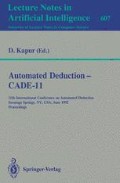Abstract
An experiment of the cover sel induction principle in RRL is presented with a proof of the Chinese Remainder theorem. To the best of our knowledge, this is the first machine proof of the theorem. The proof itself can be viewed as the correctness proof of a program which computes the least positive simultaneous solution of n congruence equations. We also discussed the problems involved in proving the theorem: designs of good specifications and induction schemes and control of rewriting.
Partially supported by the National Science Foundation Grants no. CCR-9009414 and INT-9016100.
Preview
Unable to display preview. Download preview PDF.
References
Basin, D., Kaufmann, M.: (1990) The Boyer-Moore prover and Nuprl: an experimental comparison. In: Proc. of the BRA Logical Frameworks Workshop.
Boyer, R.S. and Moore, J S.: (1979) A computational logic. New York: Academic Press.
Burstall, R.: (1969) Proving properties of programs by structural induction. Computer Journal 12(1), 41–48.
Ehrig, II., Mahr, B.: (1985) Fundamentals of Algebraic Specification. Vol. 1&2. Springer-Verlag.
Gramlich, B.: (1990) Completion based inductive theorem proving: A case study in verifying sorting algorithms. SEKI-Report SR-90-04, FB Informatik, Universität Kaiserslautern.
Hua, X., Zhang, H.: (1992) Axiomatic semantics of a hardware specification language. Proc. of the Second IEEE Great Lakes Symposium on VLSI, Kalamazoo, MI, February 1992.
Hua, X., Zhang, H.: (1992) FRI: Failure Resistant Induction in RRL. See this volume.
Jouannaud, J.-P., and Kounalis, E.: (1986) Proofs by induction in cquational theories without constructors. In: Proc. of Logic in Computer Science Conference, Cambridge MA.
Kapur, D., Narendran, P., and Zhang, H.: (1986) Proof by induction using test sets. Proc. of 8th Intl Conf. on Automated Deduction (CADE-8), Oxford, U.K.
Kapur, D., Zhang, H.: (1989) An overview of RRL: Rewrite Rule Laboratory. Proc. of the third International Conference on Rewriting Techniques and its Applications (RTA-89), Chapel Hill, NC, Springer Verlag LNCS 355, 513–529.
Musser, D.R.: (1980) On proving inductive properties of abstract data types. In Proceedings 7th ACM Symp. on Principles of Programming Languages, pages 154–162. ACM. Las Vegas, NE.
Peterson, G.L.: (1990) Complete sets of reductions with constraints. Proc. of 10th International Conference on Automated Deduction. Lecture Notes in Artificial Intelligence Vol. 449. Springer-Verlag, Berlin, pp. 381–395
Russinoff, D.M.: (1985) An experiment with the Boyer-Moore theorem prover: a proof of Wilson's theorem. J. of Automated Reasoning 1:121–139
Zhang, H.: (1992) Automated induction in algebraic specification. Research monograph (under preparation).
Zhang, H., Guha, A., Hua, X.: (1991) Using algebraic specifications in Floyd-Hoare assertions. In: Rus, T. (ed.): Proc. of Second International Conference on Algebraic Methodology and Software Technology, Iowa City, Iowa.
Zhang, H., Hua, X.: (1992) Proving Ramsey theorem by cover set induction: a case and comparison study. Presented at the Second International Symposium on Artificial Intelligence and Mathematics. Fort Lauderdale, Florida.
Zhang, H., Hua, X.: (1992) A computer proof of the Chinese remainder theorem. Unpublished manuscript.
Zhang, H., Hua, X., Kapur, D.: (1992) Use of induction hypotheses in the cover set induction: a case and comparison study. Unpublished manuscript.
Zhang, H., Kapur, D.: First-order logic theorem proving using conditional rewrite rules. In: Lusk, E., Overbeek, R., (eds.): Proc. of 9th international conference on automated deduction. Lecture Notes in Computer Science 310, Springer 1988, pp. 1–20
Zhang, H. and Kapur, D., and Krishnamoorthy, M.S.: (1988) A Mechanizable Induction Principle for Equational Specifications. Proc. of Ninth International Conference on Automated Deduction (CADE-9), Argonne, IL, May 1988. Springer-Verlag LNCS 310, pp. 250–265.
Author information
Authors and Affiliations
Editor information
Rights and permissions
Copyright information
© 1992 Springer-Verlag Berlin Heidelberg
About this paper
Cite this paper
Zhang, H., Hua, X. (1992). Proving the Chinese remainder theorem by the cover set induction. In: Kapur, D. (eds) Automated Deduction—CADE-11. CADE 1992. Lecture Notes in Computer Science, vol 607. Springer, Berlin, Heidelberg. https://doi.org/10.1007/3-540-55602-8_182
Download citation
DOI: https://doi.org/10.1007/3-540-55602-8_182
Published:
Publisher Name: Springer, Berlin, Heidelberg
Print ISBN: 978-3-540-55602-2
Online ISBN: 978-3-540-47252-0
eBook Packages: Springer Book Archive

